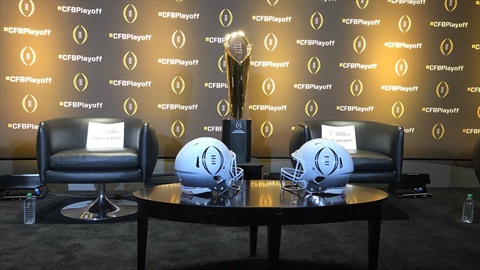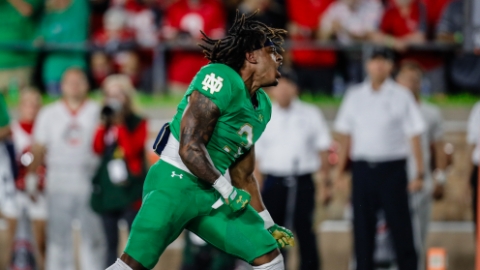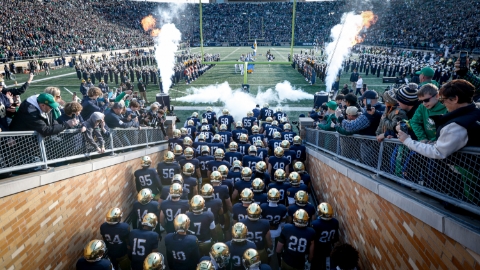
“Coach Sting” is a current coach who has spent time on both the high school and college level. He’ll be offering his expertise to Irish Sports Daily by diving into Notre Dame film and explaining what he sees. In the final bowl edition of Inside The Headset, Coach Sting examines some of the plays that didn’t go well against Iowa State.
We are back with another “Inside The Headset,” and after plenty of well-deserved high praise for Tommy Rees in his first game as playcaller against Iowa State in the Camping World Bowl, I want to dive into a play the Irish did not capitalize on right before the half and then look at the offensive series after the opening touchdown in the second half, when ND has its foot on the throat of the Cyclones neck and you would really like to see them step on it right there.
In the end, it wouldn’t prevent them from winning, but it is also good to point out that offenses need to capitalize on every possession when it comes time to line up against college football’s elite. There is not much to criticize from this particular game or knock on Rees’ call sheet, but we are going to take this opportunity to nitpick a little to shine a light on what could have been even better and what the Irish will need to take this small sample to another level.
Last Offensive Series Before The End of the Half
1st & 10 at the -24
At this point, the Irish are up 20-6 and based on the takeaways from the defense and the way the offense is rolling, they should probably be up even more. The reason I want to point out this specific moment is because with two timeouts and 45 seconds to go, this is a lifetime in college football. In college, as opposed to the NFL, the clock stops for every first down, as they hustle to spot the ball and move the chains. When the ball is set, the game clock will then start running, if the play ends with getting tackled inbounds.
Therefore, the following is a general mindset for most college offensive coordinators. While there are fewer teams than ever that huddle these days, those who still do usually will go no-huddle in a 2-minute drill, which is the scenario the Irish find themselves in here.
In addition, teams who are not all-in on a full tempo offense will switch sides of their outside WR’s depending on the play, formation, and so on. During a 2-minute drill, those teams will not do this.
It goes against conventional wisdom, but running the ball during a 2-minute drill in college actually makes lots of sense because of the ability to stop the clock on first downs while defenses are playing back to keep everything in front of them.
When there is a full stop in play (out of bounds, timeout, incomplete pass, etc), teams will tend to huddle up and regroup. Popular calls coming from the sideline to start a 2-minute Drill are runs/draws, passes that are Outs and Drags (things one can easily get out of bounds), and screens, which is what Rees dials up here.
Usually, this is a solid call and one that I am sure Rees aptly had on his call sheet from game-planning throughout the week. Generally, every game situation has calls listed on the OC’s sheet, therefore in a lot of ways, the plays are “called” before they even happen.
That part makes sense, but what is puzzling is not changing this original mindset after charting Iowa State’s defensive gameplan and the cat-and-mouse game that has taken place up to this point.
If you read the first 3 editions of “Inside the Headset,” you already know that Iowa State has pressured the Irish very little so far and when they did, they were burned. In addition, ND lined up in very few “spread” sets, however when they did, the Cyclones matched it with a 3-man rush, or at most 4.
All of that info, which the offensive staff is charting meticulously throughout the game in real time, should have led Rees to know that a screen in this situation, especially out of a 2x2 spread set (no one attached to the ‘core’ of the formation like a TE, etc) would lead to a coverage heavy defense. And while there was no way to know to what extent, the Cyclones actually go to the extreme here by “popping” a defensive lineman and thus only rushing 2 players.
The key to screens is obviously getting defenders rushing up the field and then “plus” offensive linemen down the field to block for the screen target.
From a play design standpoint, this is a really interesting screen and here is why. It was very trendy for offenses to run a fake bubble by their #2 WR in Trips (WRs are always counted from the outside-in, so the 2nd WR in) and then bringing him back for a “tunnel” type screen underneath. This widens the edge of overhang defenders and takes the ball back against the grain. A popular trend since bubble screens were all the rage for so long, making this concept a nice wrinkle/counter off the traditional bubble.
Here, the Irish change things up by “swinging” Jones Jr on what looks to be a RB Flare Screen or the RB’s version of bubble and then attempting to bring him back in the same fashion to run a middle screen.
The problem, aside from the defense dropping 9 and the dropped ball on offense, is that Jones does not get enough width on his initial path. This defeats the purpose of the play. Oftentimes, players will not get enough depth, width, etc. on plays that you don’t mass produce. Meaning, if it’s a wrinkle type play, you are less likely to get what you need on offense and players are more likely to rush things, due to their lack of being comfortable and confident on a play.
To counter this, coaches will often give landmarks that are wider or deeper than what they want on these types of plays, anticipating this happening and hoping that gets them the coveted mark to account for this. None of that happens, so with Jones not getting enough width; there is no one widening as desired, Book is forced to make an awkward throw at a tough angle, Jones can’t receive it easily and the ball is dropped, the timing is way off - so linemen cannot get out in front of the RB, and inside LB’s sit on it waiting to make the tackle if the ball is caught.
Jones should try and get to the hash before coming back in, for all of this to go as planned. A more appropriate path is illustrated in the following.

All of this amounts to a poor call and poor execution to start a 2-minute drill.
Now, instead of going for the jugular before the half ends and despite having two timeouts with plenty of time, Kelly opts to waive the white flag for the half and go in with a comfortable lead. I agree this is the call at this point with the Irish sitting at 2nd & 10 with no momentum and a long way to go to get into scoring territory.
A missed opportunity for Notre Dame here and this is an area an inexperienced play-caller will improve. Meaning, your gameplan and play design were great, but execution not so much. Also, and equally as important and a “controllable” within the game, is the ability to make slight tweaks in the game-plan according to the flow of the game and the data that is constantly under review.
It is typical for a first-time play-caller to “stick to the script,” so to speak, because they know that was all rubber-stamped before kickoff by the head coach. Live and learn for Rees and I am sure he himself will nitpick an otherwise really good job by way of lots of self-scout.
So, this one bad call led to a missed opportunity for an entire series before the close of the half. ND’s next offensive possession was a one-play, 84-yard TD run by Jones that I covered in the last “ITH.”
Second Offensive Possession of the 1st Half
1st & 10 at the -45
Their very next possession after the long touchdown run, the Irish found themselves up 27-6 and we are going to look at how they squandered a chance to virtually put the game completely out of hand barely four minutes into the second half.
Rees trades TE & Wing, Cole Kmet & Tommy Tremble, from left to right pre-snap and motions Braden Lenzy.
We covered unbalanced formations earlier and this is an example here. You cannot have 5 players in the backfield, so in order to get Lenzy off the ball so he can go in motion, Kmet needs to be “covered up” by Claypool staying lined up on the line of scrimmage post-shift.
We have learned about “Jet Sweep” already and that is what this is, right? Simply a motion man being handed the ball on the run, with a fast outside zone in that direction. In this case, all of this is accurate except the way it is being blocked.
This is a change-up from the traditional “Jet Sweep” because everyone up front is actually blocking opposite the side the ball is being handed off, except for Kmet and Tremble. As you see, after Book hands the ball to Lenzy, he then fakes the handoff to the RB. This play was made popular by the Patriots starting with Wes Welker and then Julian Edelman, being led by TE’s like Rob Gronkowski. From there, the Kansas City Chiefs used it a bunch with Tyreek Hill.
Here is an example of the Patriots running this years after they created it, with Brandin Cooks.
Here is Hill, as the Chiefs replicated this play time and time again with various formations.
From there, with the NFL being a copy-cat league, this concept caught fire throughout for just about every team in the past year or two. Here is Cordarrelle Patterson taking this play for a TD for the Raiders. Great play and concept, right? Absolutely, it makes a lot of sense in today’s game and is an example of an answer versus all of these defensive ends who “squeeze” down versus all of the Zone Read that they see these days.
Essentially, this play is designed to play into what is taught to the DE’s, which is if the tackle to his side blocks “down,” then he needs to stay tight down the line with his near shoulder to chase the RB from zone. Therefore, in that scenario, it makes great sense as a play used to counter the DE and not have to block him, which allows one more blocker to the playside.
The puzzling part of the call in the case of Rees and ND here, as ‘ITH’ established, ND’s gameplan fully took into account that the Cyclones play with an extra safety as a base and also with an odd front (3-man) and their edge players set wide. Therefore, when ND runs this play and even if everything is blocked perfectly, they would at best, have 3 blockers on 4 defenders to the playside.
A constant theme you will read from “Inside the Headset” is the numbers game. When you boil schematics down to its simplest form, that is all it amounts to and this play is no exception. In the following, you can see the defenders, including a safety running the ‘alley,’ in Gold and the number of ND blockers in Green.
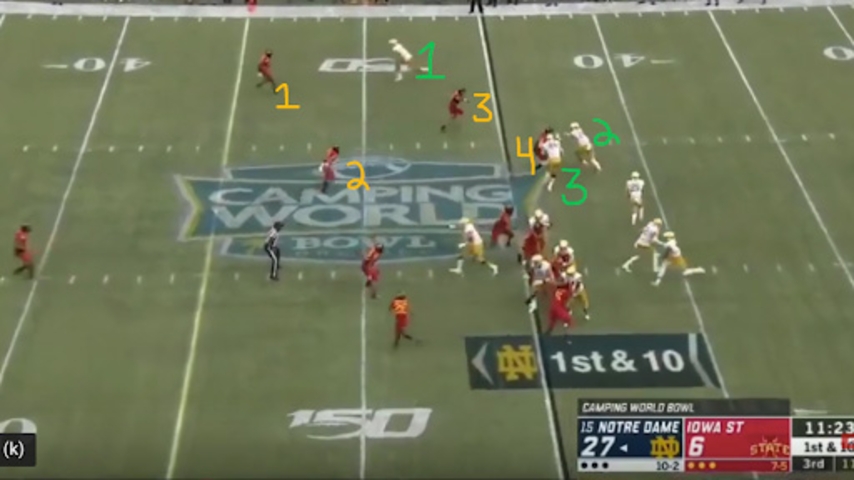
The only remaining question for me would be, why would Rees have this in the plan? Especially when just about everywhere else in the offensive game-plan, ND took in account the Iowa State scheme and for the most part, stayed one step ahead.
My answer to this is an opinion I feel has some validity and is based on seeing this often from various offensive coordinators. While I have praised Rees for his confidence as a novice OC for running the same plays with slight variations, here is a case of an inexperienced OC taking an in-vogue play and trying to squeeze into a game-plan where it does not fit.
There are so many “great play” calls and access has never been easier; in the current world of digital film, social media, multiple camera angles, etc. With all of this comes great temptation to take cool looking plays and use them in situations that either don’t call for it versus a particular defense or that don’t fit your offensive personnel or fundamentals that are regularly trained.
Here, Lenzy makes the best of it and picks up 2 yards.
Second Offensive Possession of the 2nd Half
2nd & 8 on the -47
Here, Rees goes to a simple play out of a 2X2 formation with 11 personnel (1 Back, 1 TE).
There is a good chance that the base call is mirrored routes on both sides of the ball, speed out at 5 yards by both #2 WR’s (inside WR’s) and MOR (Mandatory Outside Release) Routes Vertical by the #1 WR’s (outside WR’s).
When this is run versus 2 high safeties, which Iowa State shows pre-snap, this would call for Book to pick a side to read and then read the CB. If he sits on the speed out because he is reading the #2 WR, then you throw to the outside WR as soon as he clears the corner. If the CB bails and runs with the outside WR, then you throw the ball to the 5-yard speed out, who has outside leverage on the outside LB. This is the reason for the MOR Route. It gets the CB to turn his back to the speed out and can’t react to that route quickly, if thrown.
All of this is more than likely the original play called, however Book and Claypool execute a “sight adjustment” perfectly.
As you can see, the safety to the field immediately opens to get over the top of Claypool to double-cover him. The CB to his side also bails, giving Claypool quite the cushion. All this leads Claypool to run a 1-Step Hitch and Book delivers the ball to him in the chest immediately.
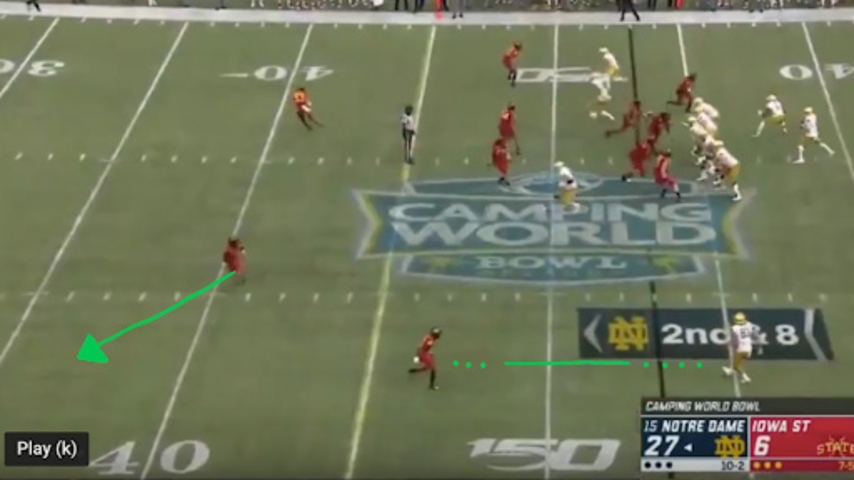
This is a rare case of numbers not necessarily being in the Irish’s favor, however sometimes you have to do things to simply get your playmakers the ball, especially in space. The thought process here is if the cornerback is playing really soft coverage and back-peddling, throw the ball out and force your worst tacklers (corners) to tackle in space.
Claypool does a good job getting up the field for 7 yards.
3rd & 1 on the +46
So the Irish need 1 yard to keep this drive alive and based off their track record in this game so far, any Lead Wide Zone is a good call, right?
Well, it is true that they have had a ton of success with this play up to this point in the game and there have been many different versions of personnel and formations used - profiting off of all of it!
The difference between those plays thus far and this call, is the fact that all of the other Wide Lead Zone calls have been handed to a Running Back. And while Ian Book is a more-than-competent runner at QB, there is no way he gets the reps in practice that this play needs in order to have success.
Alex Gibbs, the “Godfather” of outside zone, a long-time OL coach and probably best known for the Super Bowls won and rushing attack with the Denver Broncos, would run this play over and over for loads of yards with, at times, running backs who were pretty obscure or unknown.
Listening to many clinics from Gibbs, he would stress that if you are going to run this play, you better major in it. It is a very simple concept, upfront especially, but there are lots of tiny nuances, techniques, and reads that take countless reps in order to master.
While the Irish clearly made a commitment as an offense to gain their “blackbelt” in Lead Outside/Wide Zone, it’s an educated guess to say that Book spent at least 90 percent of his time pushing for depth to create a good meshpoint for the RB while repping this play, instead of becoming an expert in it as a ball-carrier. This is easy to see simply based on the path that Book takes, both with his first step and the angle in which he continues.
It may also be safe to say that Rees wasn’t paying too close attention to his Alma Mater while he was busy as a GA at Northwestern in 2015. If he had, he may have learned from the Irish watching their failed 2-point attempt versus Clemson at the end of the game. It was the same play with Deshone Kizer failing to get in, including the same late shift from the RB.
The same problem, Kizer’s path, at least partially contributed to the reason the play failed then.
When this play is taught to a RB, his aiming point is the outside leg of the tackle, but his initial read is the TE’s engagement. Meaning, if he gets the DE reached, which is rare because DE’s are taught to fight this block by keeping their outside arm free, then the RB will cruise and push to the outside and just simply go! If the DE fights the reach block and stretches the play, the RB will then stick his foot in the ground and is ideally allowed One Cut up the field.
There is one more option for the RB; if the DT fights over the top, then the RB will “cram” the ball and cut behind him, though keeping in mind that “cutting back” rarely happens. This is because that “cram” cut usually happens at the exact and initial aiming point, it is just that the entire line of scrimmage, both OL & DL, moves organically with the play.
Therefore, the RB is truly not cutting back. Conversely, this happens all of the time with Inside Zone and it is actually designed to do so (see 1st Edition of “ITH”).

Here, drawn in green, you can see the path Book should have taken and the 3 possible “cuts,” though it is usually taught that the best Outside Zone actually does not involve any cut from the RB whatsoever. It is much more efficient if he can just be “slow to it, explode through it” and “through it” meaning through the LOS/Hole.
The RB is taught that a decision needs to be made on the 3rd step. Anything before 3 steps and the crease will not present itself and anything after that will be too late and will get “muddied” up.
In Red, you can see more of the path that Book takes on this play. If Book would have tracked his correct path, it would be more on a 45-degree angle to the LOS.
We coach the ball carrier to understand that you can always bounce the play if you take a tight path, however the inverse is not always true. If you take too wide of a path, then the ball carrier needs to “wheel” himself back into the flow of the play and then is usually forced to try and cut off his inside foot in order to do so. If a ball carrier cuts off his inside foot, that is generally when you see a player slip or lose his footing. At best, you get no power, as you would if you cut off your outside leg to explode and finish the run.
The reason I felt it was important to point out the intricacies of a “simple” run concept, is to show that it is not as easy as just putting the ball in the hands of an athlete who, even as a really good runner, does not have the training or true feel for the play.
Rees rolls the dice here with Ian Book and loses.
For this day, there weren’t many losses on play calls. However, those were a few of the things that he and the Irish offense will work on heading into Rees’ first full season as Notre Dame offensive coordinator.
These two failed drives notwithstanding, it was all-in-all a good day for the former ND Quarterback!

